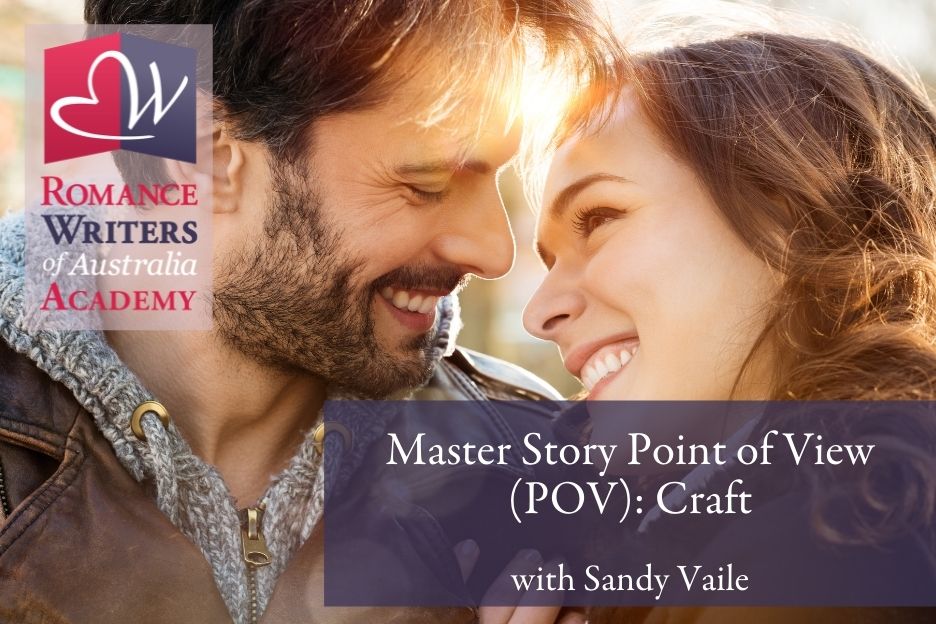There are various options when it comes to choosing the right Point of View (POV) for your romance story and they each have benefits and drawbacks. The Omniscient narrator was popular 100 years ago. First Person is favoured for a deep connection between the reader and main character. But Limited Third Person is the most common.
But why?
The most obvious reason is, romances are about two people falling in love (no matter how many demons, villains or past traumas they have to battle along the way), and therefore it makes sense to get into the hero’s and heroine’s heads, so readers can understand both of their desires and doubts. We love to experience the push and pull of a blooming romance. Feel the flutter of realisation, the denial of compatability and the accidental touches.
Benefits
- The ability to spend time in the heads of the hero and heroine during each scene, enables the author to show two different perspectives of the same situation.
They may be working towards a common goal, but have different approaches, or they may want different things out of life (initally). Seeing these conflicts build and unravel best laid plans, creates glorious expectations in the reader. Not to mention sheer terror that neither party will make the concessions it will take to come together in the end.
- Immersing readers in one character at a time, provides them adequate time to really get to know each one and care enough about them to spend eighty-odd thousand words following their journey.
The author has the scope to fully explore what the character thinks about their situation, what they desire and are motivated by, as well as what troubles and frightens them.
It also forces the author to come up with active and interesting ways to show what the non-POV character is thinking and feeling.
- It is easier to connect with a character when you are privy to their thoughts and feelings.
This can be especially beneficial when it comes to showing a hero’s vulnerability. Seeing as men tend to be less about verbalising and more about taking action, getting inside their heads reveals layers to their disposition.
Someone who might come across as obstinate or antagonistic from an outside view, can be more sympathetic when readers know why the character is acting that way.

Challenges
There are a few things that can trip you up when writing in Limited Third Person POV though.
- Head hopping can occur when authors don’t fully understand the limitations of writing in this POV, or when they aren’t sure who has the most to lose at a particular moment and therefore, swap from the hero to the heroine’s POV too often.
While there is no hard and fast rule, a good guide is to only change POV once during a chapter (depending on its length).
- Showing the same scene, two ways. Having two POV characters isn’t an excuse to show a whole scene from the hero’s perspective and then relive it through the heroine’s perspective.
Reliving time leaves readers feeling like they’re in Groundhog Day, so stick to having each character show a different moment in time.
- Narrative distance is one of the arguments against this POV; however, going into Deep POV, solves this perceived problem. Deep POV silences the narrative voice and lets readers experience only what the POV character can see, hear, taste, feel or know.
This kind of immersion in a characters heart and mind is deeply emotive, but can also be tiring. It’s all right to go deep and then pull back, so you get the best of both worlds.
- Being able to fully step into the heart and mind of two different characters, and potentially a character of a different sex to yourself, can be challenging.
It requires authors to spend equal time and energy developing both POV characters. Understanding where they came from, what motivates them, how they think and speak. Strive to create more than a cookie-cutter love interest and truly flesh them out.
Explore Your Story’s POV
When writing a romance story, Limited Third Person POV provides the perfect opportunity to reveal the heart’s desire for the hero and heroine equally. It creates the perfect environment for readers to develop a close enough relationship to care about what happens to both of them. To laugh with their joy and cry for their sorrow. To bite their nails in anticipation and hide their eyes from uncertainty. To fall in love with your characters and story as much as you do.
Sandy Vaile’s June workshop, Master Story Point of View, is the perfect opportunity to experiement with POV in a safe environment, explore what it can do for your writing and figure out which POV suits your story.
Biography

Sandy Vaile is a motorbike-riding daredevil who isn’t content with a story unless there’s a courageous heroine and a dead body. She writes romantic-suspense for Simon & Schuster US and coaches fiction authors to write novels they are proud to share (and which get noticed by agents and publishers).
Sandy is an experienced course presenter who provides a nurturing workshop environment where participants can truly absorb the material and apply it to their own work.
In her spare time, Sandy composes procedures for high-risk industrial processes, judges writing competitions, runs The Fearless Novelist Facebook group, and offers coaching and critiquing services.
Connect with Sandy Vaile on her website or social media.
Master Story Point of View (POV) – Short Course
Master Story Point of View: Recognise and write inside the heads and hearts of your characters. This workshop is for fiction writers who want to choose and use the right Point of View to showcase the emotional drama and intrigue in their story. Industry professionals are quickly put off by head-hopping and breaking POV and yet it is one of the most problematic subjects for many authors. The narrator’s perspective affects story structure, shapes the way readers experience the events and how they connect with the characters. During this workshop we will unravel the sometimes-difficult choice of which POV to use and how to deliver it consistently. Your POV delivery will be flawless in no time!
This workshop will give you the skills to:
- Recognise the different POV types and understand their benefits and drawbacks.
- Choose the POV that’s right for your story and author style.
- Write in first person.
- Write in third person limited.
- Write in third person omniscient.
- Use Deep POV to increase readers’ emotional connect to your characters.
- Handle POV changes and multiple viewpoints with ease.
- Understand the effect of POV on narrative distance and genre.
There will be plenty of opportunities to apply what you’ve learnt to your own work, examples, colourful handouts to keep and detailed feedback on your story.
Pre-course preparation
A basic ability to write English is expected.
Course Type
Craft
Hours of Commitment
5 – 10 hours
Course Dates: 5th June to 3rd July 2022
https://www.trybooking.com/events/landing?eid=864086&
Cost: RWA-Member – $55.00 Non RWA-Member – $66.00
* Please note, there is a $0.50 Trybooking fee at checkout.
Venue: Online – Moodle
(Course attendees will be notified of access/login details via email from the RWA Academy Registrar a few days prior to the start date of the course)

